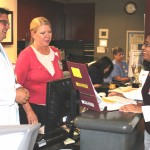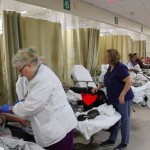
PN formulation is a complex, high-risk activity in which small errors can cause significant adverse effects.
PRIMARY CHILDREN’S HOSPITAL IN SALT LAKE CITY, Utah, has virtually eliminated parenteral nutrition (PN) errors.
This dramatic outcome is attributable to an automated electronic ordering and compounding system that allows prescribers to seamlessly enter PN criteria with the assurance that incorrect or potentially dangerous solutions will be rejected.
“The system covers prescribing, transcription, automated preparation, and labeling, and it gives prescribers everything they need right on the screen,” said Clinical Pharmacy Manager Mark W. Mackay, B.S.Pharm.
“By addressing those components, we reduced the error rate to nearly zero, leaving drug administration as the only remaining task where errors may occur.”
A Challenging Formulation
The Institute of Safe Medication Practices (ISMP) considers PN a high-alert medication because PN formulation is a complex, high-risk enterprise wherein small errors can cause clinically significant effects.
To meet the needs of practitioners, ASHP offers Guidelines for Providing Pediatric Pharmaceutical Services in Organized Health Care Systems as well as PN preparation books and resources. The National Advisory Group on Standards and Practice Guidelines for Parenteral Nutrition and the American Society for Parenteral and Enteral Nutrition (A.S.P.E.N.) also offer clinical guidelines for PN.
Yet compliance with recommended safety practices is poor, and error rates remain alarmingly high. A.S.P.E.N. reports that precautions to prevent PN errors and harm are in place at only 58% of health systems.¹
Researchers have also identified serious gaps in safe practices, most prominently the lack of computerized pharmacy order entry (CPOE) and the need to manually transcribe orders to an automated compounding device.² And according to the ISMP, error rates for complex solutions such as parenteral nutrition are as high as 37% for manual preparation and 22% for preparations that are partly automated.³
“For children, parenteral nutrition requires constant adjustments, because their needs change dramatically with age and size,” said Jared Cash, Pharm.D., BCPS, the hospital’s director of pharmacy. “From the prescribing step to formulation and administration, there are many opportunities for errors, be they misunderstandings about intended dosing, illegible handwriting, or calculation inaccuracies. The potential for injury is very high if it’s done incorrectly, and many pediatric patients have been harmed by PN.”
Solid data about PN errors is scarce, but in a four-year prospective study at a 471-bed academic teaching hospital, investigators found an error rate of 15.6 per 1,000 PN solutions.4 Errors were categorized as prescription (1%), transcription (39%), preparation (24%), or administration (35%).
Mackay saw a way to trim such unacceptably high numbers and tame the PN process from start to finish at his 350-bed facility. He assembled an interdisciplinary team composed of pharmacists, physicians, nurse practitioners, nurses, dieticians, biomedical informatics, and laboratory experts, who reviewed patient data and identified PN practices that introduced opportunities for medication errors.
The system tells me exactly what I need to do, and it knows what it can or cannot make.
Then, using software developed by the hospital’s IT department, the team fashioned a system that integrates CPOE with state-of-the-art automated drug compounding and calculates doses for each PN component based on a patient’s weight.
In January 2007, the hospital rolled out the system. For the next seven years, Mackay and his colleagues tracked its impact: Out of 84,503 PN prescriptions, only 230 errors occurred (equating to 2.7 out of 1,000 solutions).
Ninety-five percent of all errors occurred during administration, and there were no transcription errors. Twenty-one errors (9.1%) may have contributed to patient harm, but all of the events fell in the “temporary harm” category—none contributed to permanent harm. A cost analysis demonstrated average savings of $137,629 per year and a total sustainable savings of $963,403 over seven years, attributable to decreased waste elimination and direct formulary control.
Ensuring Safe Calculations, Streamlining Workflow
Users appreciate the system’s straightforward interface. A single screen with Windows prompts for CPOE also displays key information, such as recommended micro- and macronutrient levels, recommended caloric levels, and dose limits for various PN components.
“Information such as the dextrose infusion rate, the percentage of lipids and proteins, and the composition of what I’m ordering is right in front of me as I fill in the spreadsheet,” said Daniel J. Jackson, M.D., a pediatric gastroenterologist and nutrition expert at the hospital. “The system tells me exactly what I need to do, and it knows what it can or cannot make.”
For example, one of the most formidable challenges in PN is ensuring that individual ingredients don’t precipitate out of solution—a potentially life-threatening hazard. Among the most common causes of precipitation is excessive calcium phosphate, noted Dr. Cash.
“The system calculates safe levels of calcium phosphate and eliminates the risk of precipitation. You don’t need another person to intervene and tell you that the amounts are incorrect,” he said. “If the amount of calcium entered breaches dose limits, the system will reject the order.”
He added that the system has also streamlined workflow at the hospital, where 40 to 50 PN orders are active on any given day.
“The system has definitely been a welcome change, and it’s allowed pharmacists to focus on the clinical work they were trained for rather than spending a lot of time doing tedious PN dose calculations,” Dr. Cash said.
According to Vicki Basalyga, Pharm.D., BCPS, director of ASHP’s Section of Clinical Specialists and Scientists, a number of factors contributed to the initiative’s success:
- Right from the start, Mackay solicited input from a multidisciplinary team to ensure that potential errors would be caught.
- The team opted for a completely electronic system for ordering and review, thereby eliminating the need for pharmacists to decipher prescriber handwriting or transcribe orders from patient charts.
- The system tracks levels of non-nutritive additives, whose accumulation in patients receiving PN for extended periods may cause adverse events.
- The system includes triggers to ensure that age-appropriate micronutrient supplements are addressed during order verification.
“At a minimum,” Basalyga said, “all of these components should be present in every parenteral nutrition program to deliver safe, appropriate, and cost-effective care to patients.”
–By Steve Frandzel
¹ Ayers P, Adams S, Boulatta J, et al. A.S.P.E.N. Parenteral Nutrition Safety Consensus Recommendations, J Parenter Enteral Nutr. 2014;38(3):296-333. http://pen.sagepub.com/content/38/3/296.full
² Boullata JI, Guenter P, Mirtallo JM. A parenteral nutrition use survey with gap analysis, J Parenter Enteral Nutr. 2013 Mar;37(2):212-22; http://www.ncbi.nlm.nih.gov/pubmed/23112276
³ Proceedings from the 2013 ISMP Sterile Preparation Compounding Safety Summit: Guidelines for Safe Preparation of Compounded Sterile Preparations. https://www.ismp.org/tools/guidelines/IVSummit/IVCGuidelines.pdf
4 Sacks GS, Rough S, Kudsk KA. Frequency and severity of harm of medication errors related to the parenteral nutrition process in a large university teaching hospital. Pharmacotherapy 2009;29(8):966-74.










 If you want to contribute tutorials, news or other stuff please contact us. We pay 150 for each approved article.
If you want to contribute tutorials, news or other stuff please contact us. We pay 150 for each approved article. Consectetur adipisicing elit. Sed do eiusmod tempor incididunt ut labore.
Consectetur adipisicing elit. Sed do eiusmod tempor incididunt ut labore. This site uses valid HTML and CSS. All content Copyright © 2010 Newscast, Inc
This site uses valid HTML and CSS. All content Copyright © 2010 Newscast, Inc If you like what we do, please don't hestitate and subscribe to our
If you like what we do, please don't hestitate and subscribe to our